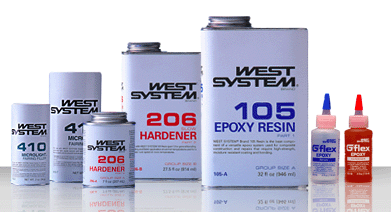
by Patrick Ropp—GBI Technical Advisor
More people are using recycled plastic/wood composite lumber for decks and other various projects. Although each manufacturer of recycled plastic lumber has his own blend, we found that most are using very similar ingredients: an equal amount of melted recycled plastic mixed with recycled wood chips or sawdust and then extruded in the form of dimensional lumber. Since the wood is encased in plastic, the plastic/wood composite boards are supposed to last longer than traditional decking materials and carry a good warranty. Many of these boards are not intended for use as structural members, but they work great for decking and other lower load projects.
Recently, a customer called us asking if WEST SYSTEM® epoxy will glue a particular type of recycled plastic lumber. Since we only had older data on a different brand, we conducted PATTI™ adhesion tests on two new brands: Trex™ Brand and SmartDeck™. The adhesion results are shown in the following chart.
| Trex | ||||
| Surface Prep | Adhesive | Cure | Adhesion | Failure Mode |
| No Prep | 105/205 | Overnight | 586 psi | 100% Substrate |
| No Prep | 105/205 | 2 Week | 586 psi | 100% Substrate |
| Sanded 80 Grit | 105/205 | Overnight | 739 psi | 98% Substrate |
| Sanded 80 Grit | 105/205 | 2 Week | 668 psi | 96% Substrate |
| Flame Treatment | 105/205 | Overnight | 617 psi | 100% Substrate |
| Flame Treatment | 105/205 | 2 Week | 617 psi | 100% Substrate |
| SmartDeck | ||||
| Surface Prep | Adhesive | Cure | Adhesion | Failure Mode |
| No Prep | 105/205 | Overnight | 607 psi | 10% Substrate |
| No Prep | 105/205 | 2 Week | 674 psi | 2% Substrate |
| Sanded 80 Grit | 105/205 | Overnight | 810 psi | 100% Substrate |
| Sanded 80 Grit | 105/205 | 2 Week | 783 psi | 100% Substrate |
| Flame Treatment | 105/205 | Overnight | 770 psi | 100% Substrate |
| Flame Treatment | 105/205 | 2 Week | 841 psi | 100% Substrate |
Different methods of surface preparation are the variables for this test. With the Trex Decking, any surface preparation (including none at all) results in substrate failure, an indication the adhesive and adhesion are adequate for the material. Even with no surface preparation, the surface seems to be rough enough to provide a good grip for the epoxy.
With the SmartDeck, we found that without surface preparation, the epoxy adhesion failed (at the interface), not the substrate. The surface was fairly smooth and just didn’t have enough “tooth” for the epoxy to grab on to. When the surface was sanded or flame treated (see below), the adhesion increased as much as 25%.
I also glued two pieces of each brand of the plastic/wood composite face to face using two step bonding and cycled them in the hot/humid hut, the cool/dry hut, the hot/dry hut, and the freezer. In the 6″ x 8″ samples, I have not seen any delamination or failure of either substrate.
In conclusion, sanded and flame treated TREX and SmartDeck produced the best adhesion. In both cases, a builder should see favorable results bonding TREX and SmartDeck (with some surface preparation) plastic/wood decking with WEST SYSTEM epoxy.
Flame treating a plastic surface for bonding
To flame treat a plastic surface, hold a propane torch flame about 4″ to 6″ from the plastic (with the tip of the flame just above the surface) and move it across the surface at a rate of 2 or 3 inches per second overlapping the previous pass slightly. Keep the torch moving and only allow the exhaust gases to hit the surface. If done correctly, the surface will not discolor or burn in any obvious way. This technique oxidizes the surface and improves adhesion. For best adhesion, bond to the surface within 30 minutes of treatment.
Sources
Trex Wood-Polymer Lumber Products
Trex Company, LLC
20 S Cameron St
Winchester, VA 22601
(540) 678-4070
www.trex.com
U.S.Plastic Lumber
2300 Glades Road
Boca Raton, FL 33431
888-733-2546
www.usplasticlumber.com
Epoxyworks 16 / Fall 2000





